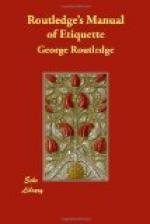LOIN OF VEAL
Is usually divided into two portions—the chump end and the kidney end; the latter of which, the most delicate part, must be separated in bones which have been jointed before cooking. Part of the kidney, and of the rich fat which surrounds it, must be given to each. The chump end, after the tail is removed and divided, may be served in slices without bone, if preferred to the richer end.
[Illustration]
FILLET OF VEAL.
The fillet of veal, corresponding to the round of beef, must be carved in the same way, in horizontal slices, with a sharp knife to preserve the smooth surface. The first, or brown slice, is preferred by some persons, and it should be divided as required. For the forcemeat, which is covered with the flap, you must cut deep into it between 1 and 2, and help to each a thin slice, with a little of the fat.
BREAST OF VEAL.
The breast is composed of the ribs and brisket, and these must first be separated by cutting through the line 1, 2. The taste of the guests must then be consulted; if the ribs be preferred, the bones are easily divided; if the brisket, which is thick, and contains the gristle, which many like, it must be in small transverse squares. The sweetbread is commonly served with a roast breast of veal, and a small portion of it must be given with every plate.
[Illustration]
KNUCKLE OF VEAL.
This part is always boiled or stewed, and the fat and tendons render it a dish much esteemed: some good slices may also be cut, and the marrowy fat which lies between two of the outer bones must be carefully portioned out.
SHOULDER AND NECK OF VEAL.
Though the shoulder of veal may be carved in the same way as mutton, it is usual to turn it over, and cut moderately thick slices from the thick edge opposite to the bone, and parallel with it.
The neck, of which the best end only is usually roasted, and stuffed under the skin, must be divided in the same way as a neck of mutton.
* * * * *
PORK.
LEG OR HAND OF PORK.
[Illustration]
Commonly the joints of pork are carved in the same way as the similar joints of mutton, in slices across, cut very deep, as marked 1, 2. In the leg, however, the close, firm flesh about the knuckle is more highly esteemed than in the same part of a leg of mutton, and must be dealt out impartially.
The hand is a delicate joint, and may be carved from the blade-bone as in mutton, or in thin, slices across, near the knuckle.




